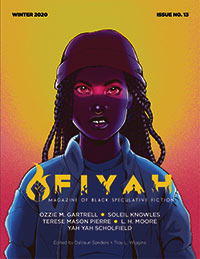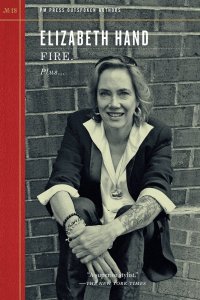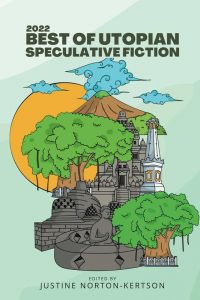Karen Burnham Reviews Short Fiction: Fiyah, BCS, Strange Horizons, and That We May Live
 Fiyah Winter ’20
Fiyah Winter ’20
Beneath Ceaseless Skies 1/30/20, 2/13/20
Strange Horizons 2/3/20, 2/10/20
That We May Live: Speculative Chinese Fiction, Sarah Coolidge, ed. (Two Lines) March 2020.
The 13th issue of Fiyah is unthemed, letting the stories come unfettered and showcasing several very new authors. The lead is “All That the Storm Took” by Yah Yah Scholfield, a harrowing tale of surviving hurricane Katrina. The structure is very interesting: first we meet Winifred bringing food to her sister, who definitely isn’t quite human anymore, in their place in Atlanta well after the storm; then we get the intense story of the flood itself in New Orleans; and then we learn about Winifred’s life after and how her sister found her again. This isn’t easy reading by any means. “Lusca” by Soleil Knowles is told in second person, where “you” are a teenaged girl whose mother keeps you firmly away from the ocean, no matter how much it calls to you; sending you away to boarding school definitely doesn’t help. The title is a bit of a giveaway if you’re tempted to learn a bit about Caribbean folklore.
My favorite story of the issue is “The Transition of Osoosi” by Ozzie M. Gartrell. In this near-future science fiction, America has become an apartheid society, divided into “True Americans” and “Citizen Americans,” the latter of which are decidedly second class. Mal’s friend Machine invents a new kind of Augmented Reality projection, one which he demonstrates by immersing Mal in a reenactment of the Dakota Pipeline water protector protests. Mal has a lot of ideas for this technology, and together they go to the hacktivist collective known as Anansi. Mal has to decide how much he’s willing to sacrifice to try to make a better society for everyone. His choice is clear, although I could wish for a little more denouement showing just what consequences Mal will have to live with.
Beneath Ceaseless Skies #296 features two stories that could loosely be considered romances. “Forgive Me, My Love, for the Ice and the Sea” by C.L. Clarke imagines a woman who joins a sailing ship on an epic journey, hoping to win a pardon for her jailed lover by assassinating the pirate queen who is seeking a death goddess in the Arctic. The epistolary tale is quite intense, as the writer keeps struggling over when, and then whether, to do the deed. In the end we’ll never know what the recipient of these letters will make of the resolution she comes home with. “The Moneylender’s Angel” by Robert Minto features a gay couple, both working the docks in a seaside town, barely scraping by. Fate drops a magical artefact in their laps, and the narrator recognizes just what it is. As they try to decide what to do with it, they reveal more of their pasts to each other, things that each believe are shameful in themselves and forgivable in their lover. It’s a well-written portrait of the couple.
Beneath Ceaseless Skies #297 features “The Ordeal” by M. Bennardo, a long-ish tale of a young lawyer visiting an imaginary European country on the advice of his father. He finds out that the country has a “justice” system involving trial by ordeal – which he first encounters when a woman tries to spin a superhuman amount of thread in an effort to save her husband, who was framed for a crime. The young man takes it upon himself to try to reform the system, moving it more towards the principles of the Enlightenment, and ultimately reaches a new understanding of both the costs and benefits of a system based on unshakeable faith. It’s a very interesting perspective, if perhaps slightly melodramatic at the bitter end.
Strange Horizons starts February with “Across the Ice” by Ada Hoffman (2/3/20), featuring an autistic character who is part of a research mission on Europa. She feels like she’s found a place where her habits such as compulsive flapping and spinning are no serious detriment to her being part of the team. When the first scans arrive from the interior of an alien structure, she is overjoyed to race home to her partner and describe a world where movement like hers might be normal instead of being constrained to human-straight hallways and corridors all the time. Both her anxiety and her joy are infectious. We also get a family story from Shannon Sanders in “Company” (2/10/20). Fay is one of four daughters of black business owners, and the only one who has stayed in the family home. She spends her days with her art and the ghosts of her ancestors, and they’re such a normal part of her life that for a minute I forgot that there was any speculative element to this story at all, they seemed so perfectly natural. Her day is disrupted when one of her nieces arrives, unannounced, with a whole lot of questions and misapprehensions about the family. Fay is not one for gushy reunions, and keeps the girl at arm’s length as we learn a lot more about her family and its story.
In the Best American Essays 2019 volume, author Rabih Alameddine has some very insightful observations on publishing in a supposedly globalized world. In “Comforting Myths” he asks questions like “who gets to tell their stories?” and he points out that in many cases an entire body of national literature gets represented by one and only one writer, who either writes in English or gets translated. There are many other points in that essay that struck home for me, but at least in terms of the one-writer-per-country issue, anthologies like That We May Live: Speculative Chinese Fiction are an important antidote. The seven stories here are from all over China (including Hong Kong), by both men and women, and deal with a variety of subject matter. The opening story, “Sour Meat” by Dorothy Tse (translated by Natascha Bruce) imagines a woman traveling for work who brings with her the strange brew that her grandmother always sends to her and her mother. As she journeys, it becomes clear that the tea is a link to something much deeper than just a beverage, and she stops overnight in her grandmother’s town, landing in a very… organic… hotel room. Another deeply feminine story is the finale, “Flourishing Beasts” by Yan Ge (translated by Jeremy Tiang). The beasts of the title have mostly normal human female appearances and intelligence, but grow like plants from pieces of their deceased ancestors. Sometimes these saplings are cut down before they mature, to make particularly rare and fine furniture. The narrator of this story is intimately familiar with these beings, and goes to stay with one of them when a man begins harassing her with a marriage proposal. What might be a straightforward tale of abuse by patriarchal figures is complicated at the end by the narrator’s interactions with the beasts and their artefacts.
Enoch Tam provides two stories about how cities change and grow over time (both translated by Jeremy Tiang). “Auntie Han’s Modern Life” imagines a successful shopkeeper who builds a life for herself, even as her district sometimes disappears at night and houses relocate themselves. A man of her acquaintance ends up joining the “garden-keepers” seeking to keep the houses in her neighborhood from moving around, and also possibly scouting for resources – she pointedly declines to help him. The garden-keepers show up again in “The Mushroom Houses Proliferated in District M“. Here the eponymous houses are marvels of organic efficiency, providing ecologically sustainable infrastructure for the inhabitants. But even such organic development can be pushed too far, and in this district the mushrooms start to go bad. One of my favorite stories in the volume is “A Counterfeit Life” by Chen Si’an (translated by Canaan Morse). A down-on-his-luck job seeker is mistaken for a wedding emcee and hurriedly pressed into service. While his performance is lackluster, he realizes that there are ample opportunities to step into generic roles: guest, catering assistant, background member of a business meeting, even a date when someone is simply expecting “a guy” to show up. While he starts making a living filling these moment-to-moment vacancies in the world, he also starts showing other people how to do the same, all informally through word-of-mouth. Some of them take to the life and some of them don’t. It’s an interesting perspective on our expectations of those around us, and how sometimes it takes only the slightest effort to fold a societal cloak of invisibility around yourself. Overall, this is a strong collection with a number of valuable perspectives, well worth the time for any SF/F fan to seek out.
Recommended Stories
“A Counterfeit Life”, Chen Si’an (That We May Live)
“The Transition of Osoosi”, Ozzie M. Gartrell (Fiyah #13)
“Noah’s Raven”, Kij Johnson (Lightspeed 2/20)
“The Gamecocks”, JT Petty (Lightspeed 2/20)
Karen Burnham is an electromagnetics engineer by way of vocation, and a book reviewer/critic by way of avocation. She has worked on NASA projects including the Dream Chaser spacecraft and currently works in the automotive industry in Michigan. She has reviewed for venues such as Locus Magazine, NYRSF, Strange Horizons, SFSignal.com, and Cascadia Subduction Zone. She has produced podcasts for Locusmag.com and SFSignal.com, especially SF Crossing the Gulf with Karen Lord. Her book on Greg Egan came out from University of Illinois Press in 2014, and she has twice been nominated in the Best Non Fiction category of the British SF Awards.
This review and more like it in the April 2020 issue of Locus.
 While you are here, please take a moment to support Locus with a one-time or recurring donation. We rely on reader donations to keep the magazine and site going, and would like to keep the site paywall free, but WE NEED YOUR FINANCIAL SUPPORT to continue quality coverage of the science fiction and fantasy field.
While you are here, please take a moment to support Locus with a one-time or recurring donation. We rely on reader donations to keep the magazine and site going, and would like to keep the site paywall free, but WE NEED YOUR FINANCIAL SUPPORT to continue quality coverage of the science fiction and fantasy field.






